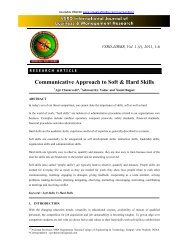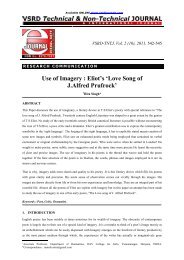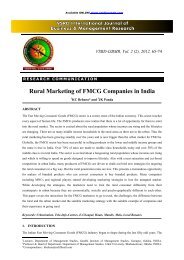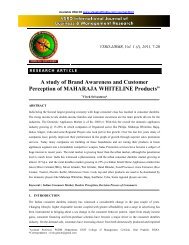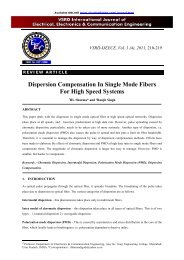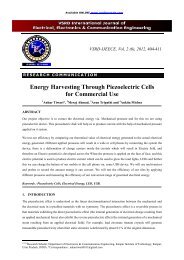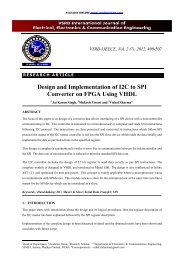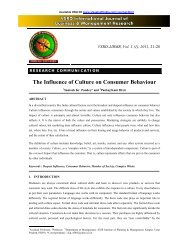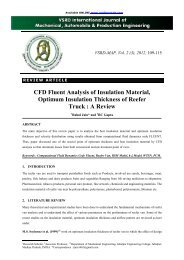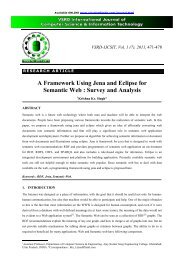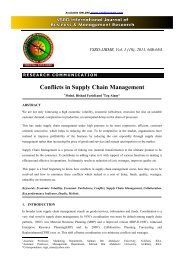Break Down Of Marketing P's : âA New Evolutionâ - vsrd international ...
Break Down Of Marketing P's : âA New Evolutionâ - vsrd international ...
Break Down Of Marketing P's : âA New Evolutionâ - vsrd international ...
Create successful ePaper yourself
Turn your PDF publications into a flip-book with our unique Google optimized e-Paper software.
Available ONLINE www.visualsoftindia.com/journal.html<br />
VSRD-IJBMR, Vol. 1 (1), 2011, 59-63<br />
S H O R T C O M M U N I C A T I O N<br />
<strong>Break</strong> <strong>Down</strong> <strong>Of</strong> <strong>Marketing</strong> P’s : “A <strong>New</strong> Evolution”<br />
1 Pradeep Kr.* and 2 Jugesh Aspal<br />
ABSTRACT<br />
The 4 P’s model given by Philip Kottler was very successful initially but when it extended to service industry it<br />
be came 7P’s and was very successful initially but due to intense competition by the rivals these two models<br />
proven Gospel. So, business firms were forced to develop and follow model of their own to cater the needs and<br />
wants of the customer in customize manner. Despite of traditional models like 4 P’s & 4 C’s model for<br />
manufacturing concern & 7 P’s models for service industry google’s has followed an unconventional model &<br />
disrupter all the traditional ones, which can be a example for the others. Due to competition given by other<br />
competitors it was forced to develop a new business model which could out weight others.<br />
So, google created its own model in which it eliminated all the 3 P’s out of 4 P’s & retained only one ‘P’ that is<br />
product. In spite of eliminating 3 P’s it is still successful in creating billions & is market leader in its particular<br />
segment. It is also one of the top five companies in terms of creating billions across the globe. It is know a trend<br />
setter in the market place and is proven as a market leader in all respect. It is creating landmark for the others to<br />
achieve. Despite of following traditional models. It has followed very un-usual yet successful model.<br />
Keywords : 3P, 4P, 4C, 7Ps.<br />
1. INTRODUCTION<br />
Philip Kottler is not a new name in the world of business not only because of his contribution to business world<br />
but also his auspicious 4 P’s model which is used by almost very business firms & is considered as backbone of<br />
the marketing worlds. His 4 P’s model is well known & very eminent for the business world. It is considered as<br />
the foundation of the business & is included in the books of every institute & is the part of every syllabi of<br />
business stream in each of every university.<br />
His 4 P’s model consists of product, price, place, promotion. If we look around. His model seems to be very true<br />
____________________________<br />
1 Research Scholar, Department of Management, Singhania University, Jaipur, Rajasthan, INDIA.<br />
2 Director, Administration Department, Shri Ram College of Management, Muzaffarnagar, Uttar Pradesh, INDIA.<br />
*Correspondence : pradeep9335513146@gmail.com
Pradeep Kr. et. al / VSRD International Journal of Business & Management Research Vol. 1 (1), 2011<br />
and feasible for every firm especially for the firms producing goods. When it comes to service industry his 4 P’s<br />
models extends to include 3 more P’s named as process, people & physical infrastructure.<br />
Initially his 4 P’s model was a success but when it comes to practical condition of dynamic business<br />
environment it wasn’t last long & it was considered as the limitation of Kottler 4 P’s model. So in order to cope<br />
up with emphatic & highly dynamic environment his 4 P’s models was replaced by 4 C’s models like below<br />
Product – Customer need & wants<br />
Price – Cost of Satisfy<br />
Place – Convenience of Buyers<br />
Promotion – Communication<br />
This 4 C’s model was developed by famous marketing guru Arindam Chaudhary. He picked the limitations of 4<br />
P’s model to develop his research. This 4 C’s model is generally developed to eliminate, explain & removes all<br />
the drawnbacks of 4 P’s Models.<br />
The 4 P’s model developed by Kotler was emphasis on seller perspective & 4 C’s model was strictly in<br />
accordance with Buyer’s Perspective. The explanation given in 4 C’s Model is as follows.<br />
Seller<br />
Product<br />
Price<br />
Place<br />
Promotion<br />
Customers<br />
Customer need & wants<br />
Cost of Satisfy<br />
Convenience of Buyers<br />
Communication<br />
2. CONSUMER NEEDS & WANTS (VS PRODUCT)<br />
We can’t develop product & then try to sell them to mass market. We are required to study consumer needs and<br />
wants & then attract consumers one by one with something each one wants. Hence, we should customize our<br />
product according to their needs and wants.<br />
3. COST OF SATISFY (VS PRICE)<br />
We are required to realize that price what we sell the product for is only one part of the cost to satisfy. If you sell<br />
me for example you have to consider the cost of driving your restaurant. But what if you provide a delivery<br />
service Pricing is one of the most difficult decision. To make selling at the lowest price is not always the best<br />
option. Ifyou rely strictly on price to compete, you are more vulnerable to competition.<br />
Page 60 of 63
Pradeep Kr. et. al / VSRD International Journal of Business & Management Research Vol. 1 (1), 2011<br />
4. CONVENIENCE TO BUY (VS. PLACE)<br />
You must think of convenience to buy instead of place. You have to know how each subset of the market prefers<br />
to buy on the internet from a catalogue, on the phone, using credit cards etc Amazon Books & Dell Computers<br />
are just a few business that do very well over the internet.<br />
5. COMMUNICATION (VS. PROMOTION)<br />
You have to consider communication instead of promotion, promotion is manipulative – it’s a statement from<br />
the seller. Communication requires a give & take between the buyer & seller. This is much more subtle. Be<br />
creative & you can make any advertising interactive. Use phone numbers, your website address, etc to help here.<br />
“Orange Wednesday is a good example.<br />
Developing a brand was considered as fruitful when we took into consideration the 4 C.s noted above with this<br />
we can begin the process of developing a brand.<br />
6. WHAT TRIGGER TO BRING CHANGES IN 4 C’S MODEL OF MARKETING MIX<br />
The marketing mix model based on 4 C’s was used by business organization widely to help them to decide how<br />
to take a new offer to market. It was also used to test their existing marketing strategy. Whether marketers<br />
consider a new or existing offer, following steps given below help marketers to define & improve their<br />
marketing mix.<br />
1. Start by identifying the needs & wants of the consumers.<br />
2. Now go through & answers the 4 C’s questions arising in your mind.<br />
3. Once you have a well defined marketing mix try testing the overall offer from the customer’ s perspective<br />
by asking customer focused questions:<br />
a. does it meet their needs” (need & wants)<br />
b. will they find it where they shop (convenience to shop)<br />
c. will they consider its price favorably (Cost of satisfaction)<br />
d. And will the marketing communication reach them (Communication)<br />
e. Keep on asking questions & making changes to your mix until you are satisfied that you have<br />
optimized your mix. Given the information & facts & figures you have available.<br />
f. Review your marketing mix regularly to cope up changes<br />
But this model of marketing mix also faced heat of competition & it was assumed that we don’t have any<br />
specific or universal model which can lead us to success & it is assumed that in this dynamic business<br />
environment, we are required to define a new business model. This is the reason why companies are using<br />
different business models to succeed in dynamic business world.<br />
Page 61 of 63
Pradeep Kr. et. al / VSRD International Journal of Business & Management Research Vol. 1 (1), 2011<br />
7. THE RAMPAGE OF 4 P’S & 4 C’S<br />
Kottler 4 P’s & Arindam’s 4 C’s of marketing selling the product, price, place, promotion & customer need &<br />
wants, cost of satisfy, communication & convenience to buy right is considered on gospel for modern business.<br />
Suppose a very fundamental question but not irrelevant question: what will happen to 4 P’s principal if three out<br />
of 4 P’s are zero.<br />
For example:<br />
Product - Present<br />
Price - 0<br />
Place - 0<br />
Promotion - 0<br />
This seems to be totally irrelevant but this is successfully followed by google’s. Google’s which is one of the<br />
top five companies in terms of wealth declared by forbe’s magazine.<br />
Google’s single P formula to achieve the two most elusive Ps of business popularity (75 percent share of the<br />
internet search) & profit (14.3 billion in 2 to 8 at a margin of almost 30%) has confounded many.<br />
If we talk about google then google has only one P that is product & all other three Ps are zero. Because<br />
google’s products are free is means the price for google product is zero. Google doest not advertise at least yet it<br />
means promotion is also zero. Last but not the least there is not any specific placement of its product, the<br />
internet which is used by google is only platform it means place is also zero.<br />
8. HOW MUCH SUCCESS GOOGLE IN GETTING BY ELIMINATION 3 OUT OF 4P’S<br />
Conceptually the internet is challenging the media; It is forcing not to follow us traditional business models.<br />
That will happen with or without google in the mix.<br />
Google is spending 70% of its time working on its core search business. 20% of the time is spent on related<br />
technological project & the remaining 10% on whatever it wants to do. Through this is how the innovation<br />
comes.<br />
9. ESSENTIAL INFORMATION<br />
Any company keen on advertising on google needs to know that the success of its is based on three things. The<br />
price it is willing to pay, key words in the search that it would like to bid on, the quality of its website. Unlike it<br />
conventional advertising, the price is not the most proper criteria. Also, an advertiser pays only when a web<br />
surfer clicks on its ads.<br />
10. QUALITY CONTROL<br />
The quality of the web site which an ad-clicks leads to a key determinants of where the ad will rank & has much<br />
it will cost. The quality most probably depend on variety of factors such on relevance of the website vis& vis the<br />
Page 62 of 63
Pradeep Kr. et. al / VSRD International Journal of Business & Management Research Vol. 1 (1), 2011<br />
search terms, bound rate (speed at which a surfer navigator away from webpage).<br />
11. GOLD EARNING EQUATION<br />
Remember the famous black scholes option pricing equation, that brought a revolution in finance & derivatives<br />
& want the author a noble price. Google has its own formula for figuring out how to price its ads that promises<br />
to revolutionize the online advertising world.<br />
Price Paid By Advertiser = Amount of Mix Highest Bid + Quality of Next Highest Bid<br />
Quality of Advertisers Bid<br />
12. CONCLUSION<br />
Obviously the winner is google, it has successfully disrupted the traditional models of 4 P’s & 4 C’s and has<br />
introduced its unconventional model. Also it is earning so heavily that it can be a role model for the emerging<br />
companies to get success in business world. So its is the leader & winner also in all respect.<br />
13. ACKNOWLEDGEMENT<br />
*****<br />
14. REFERENCES<br />
[1] Kottler Phillip, Keller, Kevin Lane, Koshy Abranam, Jha Mithleshwar, “<strong>Marketing</strong> Management”, 12 th<br />
edition; 102-103<br />
[2] Joel R. Evans, Ban Benman, “<strong>Marketing</strong> 8c, reprint edition 2010, 661<br />
[3] Michael J. Etzel, Bruic J. Wulzer, William J. Stantor, Ajay Pandit, <strong>Marketing</strong>, 4 th edition, 73-80.<br />
[4] Kumar Sandeep, “ 4 P’S of <strong>Marketing</strong>, Vol. IV, 5 th issue ; 102-105<br />
[5] Saran Rohit, Mitra Kushan, Aiyar Shankar, Business Today, September 6,2009 edition;30-35<br />
[6] Banting, Peter; Ross, Randolph E.. "SpringerLink - Journal of the Academy of <strong>Marketing</strong> Science, Volume<br />
1, Number 1". SpringerLink.<br />
[7] Koichi Shimizu (2009) "Advertising Theory and Strategies,"16th edition, Souseisha Book Company.<br />
(Japanese)<br />
[8] Koichi Shimizu (2003) "Symbiotic <strong>Marketing</strong> Strategy,"4th edition, Souseisha Book Company.(Japanese)<br />
[9] E. Jerome McCarthy (1975) “Basic <strong>Marketing</strong>: A Managerial Approach”, fifth edition, Richard D. Irwin,<br />
Inc., p.37<br />
[10] Don E. Schullz, Stanley I. Tannenbaum, Robert F. Lauterborn (1993) “Integrated <strong>Marketing</strong><br />
Communications,” NTC Business Books, a division of NTC Publishing Group.<br />
<br />
Page 63 of 63



